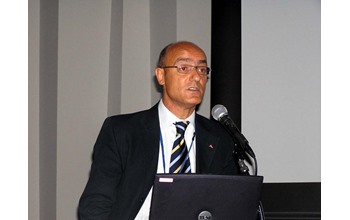AM FAA FTSE Hon FIEAust Dist M ASCE
Professor Harry Poulos' pioneering work in pile foundation analysis and design has enabled the world's geotechnical specialists to have a greater understanding of the way structures interact with the ground. His research has enabled a more reliable approach to be adopted for pile design, replacing procedures which previously relied purely on experience and empiricism.
Professor Poulos has applied his research to a wide range of major projects, both in Australia and overseas, including buildings, bridges, tunnels, freeways, mines, airports offshore structures (e.g. oil rigs) and earthquake-related problems. Professor Poulos' work includes the Emirates Twin Towers in Dubai, where his analysis and design of the piled raft foundations provided significant cost benefits for the twin towers exceeding 300 metres in height, the Burj Khalifa, now the world's tallest building, where he was the geotechnical peer reviewer, the Docklands project in Melbourne involving design of remedial pile foundations for one of the high rise residential developments, and the construction of a 700km long motorway in Greece using his expertise in slope stabilisation and earthquake engineering.
While retaining his professorial position at the University of Sydney, Professor Poulos joined the Coffey Group in 1989, as the Director of Advanced Technology, and became Chairman of Coffey International Pty Ltd in 1991, a position that he held for two years. In the period 1998 to 2002 he served as Director of Technical Innovation and General Manager, Technical Development.
Professor Poulos has long been a contributor to the activities of the international geotechnical community. He was also a long-term member of the National Committee of the Australian Geomechanics Society (AGS) (1980 to 1995) and its Chairman from 1982 to 1984. He was Committee Member of the AGS Sydney Group, 1971-76, 1979-2002, Vice-chairman 1974 and Chairman 1980-81. He was the Australasian Vice-President of the International Society for Soil Mechanics and Foundation Engineering in the period 1989-1994, an appointed Board Member of the Society from 2001 to 2005, and is currently the Chair of the Membership, Practitioner and Academic Committee of the Society.
He was recognised by his peers for his contributions to Australian Geomechanics by the Sydney Chapter via the institution of the annual Poulos Lecture in 2002.
Professor Poulos is a recipient of many prizes and awards, including Australia's Centenary Medal (2003) for his services to Australian society and science in the field of geotechnical engineering. His overall contribution to the engineering profession has been recognised formally by the award of Member of the Order of Australia (1993), his election as Fellow of the Australian Academy of Science (1988), his Fellowship of the Australian Academy of Technological Sciences and Engineering (1996), his Honorary Fellowship of the Institution of Engineers Australia (1999), the award of the Warren Prize (1972) and Warren Medal (1985) of the Institution of Engineers, Australia, his selection as the 2003 Australian Civil Engineer of the year, and his selection in 2004 as the inaugural Geotechnical Practitioner of the year.
Professor Poulos gave the prestigious Rankine Lecture of the Institution of Civil Engineers (UK) in 1989, and was invited by the American Society of Civil Engineers (ASCE) to deliver the annual Terzaghi lecture in 2004. He also received from ASCE the 1972 Croes medal, the 1995 State of the Art Award, and the 2007 Middlebrooks Award. In 2010, he was elected as a Distinguished Member of ASCE, the first Australian Civil Engineer to be so recognised.
Prof. Dr. Eng. Alessandro Mandolini;
Chairman of ISMMGE TC212 Deep Foundation

EDUCATION
1994: Ph.D in Geotechnical Engineering
1989: Graduated in Civil Engineering (5 years) at the University of Napoli “Federico II”, Italy
HONORS
Awards
1995: Italian Geotechnical Association (AGI) Award for the PhD thesis
1998: Gold Research (Bishop) Medal of the Institution of Civil Engineering of London (UK) for the best contribution published on the scientific journal Geotéchnique in 1997.
2008: IACMAG Excellent Paper Junior Award for the paper published on the scientific Journal for Geotechnical and Geoenvironmental Engineering of the American Society of Civil Engineering (ASCE) in 2006.
Main Distinctions related to Recognition of Scientific Work
-Elected Chairman of the ISSMGE TC212 “Deep Foundations” (2015-now)
-Member in the following Technical Committees of the International Society for Soil Mechanics and Geotechnical Engineering (ISSMGE): ERTC3 “Piles” (2001-now); ERTC10 “Evaluation of Eurocode 7” (2005-now);
-Nominated member by the UNI/CIS/SC7 for the “Eurocode 7” (2008-now)
-Referee for several International Journals, Reviewer for several National and International Conferences, Foreign Examiner of Doctoral Dissertations
-Invited Lecturer, Keynote Lecturer at several national and international Conferences
-State-of-the-Art Reporter on Pile Foundations at XVI International Conference on Soil Mechanics and Geotechnical Engineering held in Osaka (Japan) in 2005.
PUBLICATIONS
-Author and/or co-Author of more than 130 papers for scientific journals, national and international Conferences.
-Co-Author of a book titled “Piles and Pile Foundations” edited by CRC Press Taylor & Francis Group.
Starting from the pioneering papers published in 1968 by Poulos dealing with single pile and pile groups, significant advances have been made in field of pile foundations. New pile types, improved method of analysis and more rational design approaches are now available for practical purposes.
Thanks to the availability of powerful computers and numerical analysis tools, we are now in the position to investigate very complex problems (geometry; loading conditions; material properties, etc.). However, all calculations, no matter how sophisticated and complex, cannot be more than rough approximation of the natural phenomenon they try to represent by means of a model. It follows that it is fundamental to check the outcomes of complex models and/or analyses with more simple methods, where possible.
When this methodological approach has been followed, significant advances have been registered in approaching pile problems.
In the presentation, a tentative is made to “align” those fundamental steps which made possible significant advances in the field in the last 50 years (1968-2018).